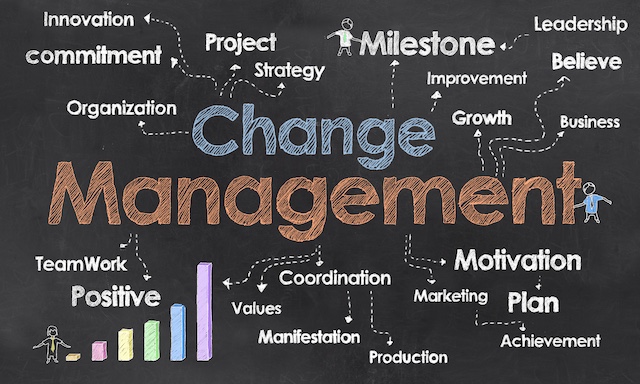Organizational change can be highly disruptive to a business, affecting its workforce, productivity, efficiencies, and performance. Companies unprepared for change lack resiliency and may incur damage that could otherwise be avoided. But with the right change management processes in place, they can reduce risk and emerge stronger on the other side.
This article unpacks change management, from its core definition to actionable steps and workplace examples, so you can learn how to navigate transitions confidently and gain the power to pivot, adapt, and lead through challenging times.
What Is Change Management?
Change management is the structured approach organizations use to transition individuals, teams, and systems from a current state to a desired future state. It involves planning, executing, refining, and reinforcing changes to minimize disruption and maximize adoption. Change management ensures that processes, technology, and/or culture shifts align with organizational goals.
Why is it necessary? Change is inevitable, resulting from shifts in market demands, technological advancements, and competition. Effective change management reduces resistance, boosts morale, and enhances productivity, allowing performance to improve and the organization to innovate and grow.
The Two Types of Change Management
There are two types of organizational change: transformational and adaptive change.
Transformational change is bold and sweeping. It redefines an organization’s strategy, structure, or culture, like a company pivoting from brick-and-mortar to e-commerce. It’s high-stakes, often requiring a complete mindset shift. It can result in corporate restructuring, mergers, moves, layoffs, and more. As a consequence, it demands strong leadership and clear communication to overcome resistance.
Adaptive change, on the other hand, is incremental and reactive. It tweaks existing systems without upending them—like updating software or adjusting workflows to improve efficiency. It’s less disruptive but can still face pushback if not managed well. For example, a team adopting a new project management tool might grumble initially but adapt with proper training.
The key difference? Transformational change reshapes the core, while adaptive change refines it. Both require planning, but transformational efforts need deeper buy-in and longer timelines.
How to Set Up a Successful Change Management Process in 5 Steps
If your organization is facing a major shift—downsizing, rebranding, merging, or reimagining its business model—here’s a five-step approach to lead transformational change with intention and integrity.
1. Prepare the organization for change
Transformational change often begins with hard truths: shrinking margins, market disruption, or the need to restructure to survive. Leaders must address those realities head-on and help employees answer two essential questions:
- Why is this change happening now?
- What happens if we don’t adapt?
First, you must also assess internal capacity to handle the change. Do middle managers have the communication skills to guide their teams? Are support resources (like HR, internal comms, or IT) equipped to help? Identifying roadblocks—whether it’s skill gaps, burnout risk, or budget constraints—early allows you to build credible mitigation strategies.
If your company is initiating layoffs, consolidating departments, or shifting its business model, the next step is creating both emotional and operational readiness. Employees need transparency—not just about what’s changing, but why. A leader who clearly explains the business case behind workforce reductions or structural overhauls can reduce uncertainty and rebuild trust, even in difficult moments.
2. Craft a vision and plan for change
Transformational change isn’t just about doing things differently—it’s about becoming something different. That kind of shift can be unsettling, so your organization needs a clear and compelling vision to serve as its North Star.
The vision should answer:
- What are we moving toward?
- Why is this necessary for our survival or success?
- How will this benefit our employees, customers, and company in the long run?
For example, if your company is restructuring following a merger or downsizing to invest in automation, your vision might center on building a leaner, more future-ready organization. It should communicate the benefits of the change without glossing over the challenges. This isn’t spin—it’s leadership.
Pair the vision with a strategic change plan that includes:
- Business goals (e.g., cut fixed costs by 20%, shift 60% of sales online)
- KPIs to track progress (e.g., attrition rates, engagement scores, time-to-retrain)
- Stakeholders and decision-makers—who’s leading the change, who’s accountable
- Timelines for key initiatives, from department realignment to tech rollouts
- Boundaries—what won’t change, and what’s non-negotiable
The plan should also outline support systems for organizations undergoing layoffs: outplacement resources, internal reassignments, and retraining opportunities. It’s not just about what’s changing—it’s about how people will be taken care of along the way.

3. Implement the changes
This is where strategy turns into reality. At the transformational level, execution is both a logistical effort and a leadership moment. You’re asking people to let go of what’s familiar—possibly including coworkers, job titles, or entire workflows—and move into uncertainty. That transition must be handled with care.
Here’s how to make it effective:
- Equip leaders and managers to lead with clarity and compassion. Managers should know how to handle sensitive conversations and deliver consistent messaging.
- Provide robust support, especially for those directly impacted. This includes severance, outplacement services, internal mobility opportunities, and resources for emotional well-being and resilience.
- Empower teams with tools and training to succeed in the new structure, whether it’s mastering a new sales platform or operating within a leaner team.
Even within transformational initiatives, adaptive change plays a critical role. A company restructuring around a digital model might also need to roll out a new CRM, adjust reporting workflows, or retrain staff on updated policies. These smaller, tactical shifts require:
- Thoughtful onboarding and training
- Pilot testing before full implementation
- Feedback loops to quickly catch and correct issues
Quick wins, like a faster reporting process or successful talent redeployment, can energize teams and show that the plan is working. But don’t ignore the pain points. Create formal feedback loops—surveys, team check-ins, anonymous Q&A boxes—to stay attuned to frontline concerns and course-correct as needed.
4. Embed changes into culture and practices
Anchor the change by weaving it into the company’s DNA. Update workflows if needed, implement new reward systems (bonuses for tech adoption), and make structural shifts (a flatter org chart) as necessary. After a merger, for instance, joint team rituals can solidify unity.
Embedding requires consistency across systems and leadership behaviors. If leaders revert to old messaging, so will their teams. Formalizing new processes in documentation, performance reviews, and onboarding ensures the change becomes self-sustaining over time.
5. Review progress and analyze results
It’s crucial to evaluate progress along the way and make adjustments when needed. Survey employees and keep lines of communication open. At the close of your plan, assess outcomes against goals. Did efficiency spike? Did morale hold? A post-mortem reveals wins that are replicable elsewhere or flops that shouldn’t be repeated, such as rushed training. A sales team’s tech upgrade might show 20% more leads—great. If not, dig into why. These insights fuel smarter future changes.
This phase isn’t just about reporting results. It’s about translating learnings into action. Use these lessons to refine playbooks, develop targeted coaching, or pivot future initiatives. Continuous improvement only happens when honest analysis, rather than assumption, drives decisions.
Examples of Workplace Change Management
Change management plays out every day in business situations. Here are some real-world examples where effective change management can make or break the outcome:
Change in leadership
When a key leader exits, it creates a ripple effect across teams. A strong change management approach initiates a clear succession plan, reassigns responsibilities, and ensures knowledge transfer through mentoring or documentation. Transparent workplace communication about the transition helps keep employees informed and engaged. Without it, uncertainty can lead to low morale or further turnover. But when handled well, the team regains stability, and new leadership can inject fresh energy.
Organizational restructuring
Flattening a company’s hierarchy or reshaping departments can create anxiety. Titles may disappear, and reporting lines shift. In these moments, leaders must communicate the “why” behind the change—whether it’s faster decision-making, better collaboration, or reducing operational silos. Role clarity, training, and support during the transition are essential. Change management ensures employees don’t just adapt but understand and embrace the new structure.
Layoffs and downsizing
This is one of the most sensitive forms of organizational change. Poor communication or a lack of empathy can destroy trust. A thoughtful change management strategy includes honest messaging about the reasons for layoffs (e.g., focusing on core business), career transition support for departing staff, and reassurance for those who remain. Providing resources like severance, outplacement assistance, and transparent timelines helps reduce panic and maintain productivity.
Mergers and acquisitions
Combining companies means merging not just systems but cultures. Change management supports this integration by building shared goals, encouraging collaboration, and fostering a joint identity. Skipping this work leads to culture clashes and lost talent.
Adopting new technology
Rolling out new technology solutions or platforms, like an AI-driven sales tool, often triggers resistance. But when change is introduced with hands-on training, clear benefits (e.g., doubling lead conversions), and internal champions who model the new behavior, adoption grows.
In each case, successful change depends on clear communication, strong leadership, and consistent follow-through.
Final Thoughts on Change Management
Whether you’re introducing new technology, navigating a merger, or responding to market pressures, your organization’s resilience and relevance will be determined by your ability to lead change with clarity and purpose.
Change management is about building trust, communicating transparently, and guiding teams through uncertainty with empathy and structure. The most successful organizations don’t just manage change—they make it part of their culture. They prepare thoughtfully, plan strategically, act decisively, and embed change so thoroughly that progress becomes second nature. And just as importantly, they learn from every initiative, using insights to fuel smarter moves in the future.
Change may be constant, but with the right approach, it doesn’t have to be chaotic. Instead, it becomes a powerful catalyst for innovation, growth, and long-term success.
INTOO can support your organization through change with its award-winning outplacement and career development programming. Whether offering expert career transition assistance to your impacted employees or training and coaching remaining employees to adapt to their new responsibilities, we have solutions that can ensure a successful change. Contact us today to learn more.











